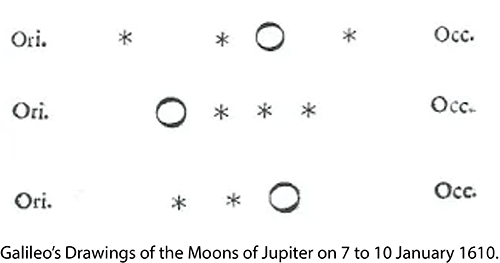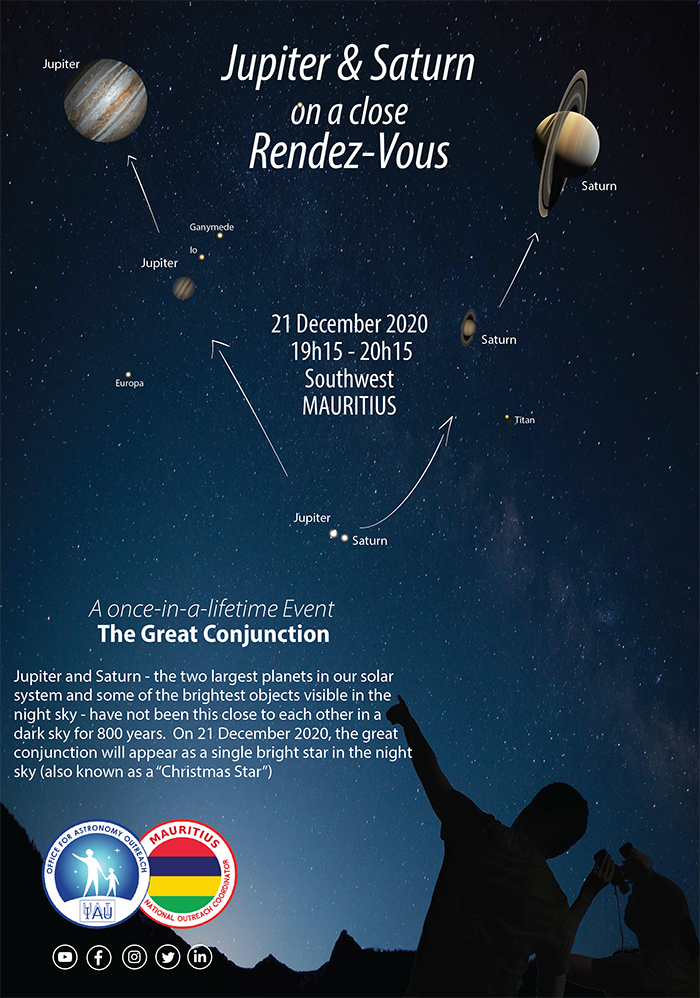Astronomy enthusiasts are in for an end-of-year extravagance. December 21st will be memorable and remarkable for observational and amateur astronomers! What has become known prevalently as the “Christmas Star”, in reference to the Star of Bethlehem, is an exclusively vivacious planetary conjunction easily observable in the evening sky. The most celebrated planets, Jupiter and Saturn, will be exceptionally close as seen from Earth (separated by a mere 0.1°; this is just a fifth of the full moon’s size!) and is referred to as ‘Great Conjunction – 2020’. This will be the closest Jupiter/Saturn conjunction since the year 1623 BC!
What is a Great Conjunction?
A “great conjunction” is a conjunction of the two biggest planets Jupiter and Saturn; it transpires when those planets appear unbelievably close to one another in the sky because they line up with Earth in their respective orbits. A conjunction of Jupiter and Saturn is comparatively sporadic and it happens about once every 20 years due to the combined effect of Jupiter’s approximately 12-year orbital period and Saturn’s approximately 30-year orbital period. For this reason, it is known as the great conjunction.
As it travels around the Sun, Jupiter catches and moves past slower orbiting Saturn – in a somewhat regular 20-year pattern. While the two planets may be watched as a single point of light on the sky’s dome, Jupiter and Saturn will actually be 734 million km apart. They will remain in close alignment for a few days and will be effortlessly perceptible to the naked eye when looking towards the southwest just after sunset. Throughout the night, Saturn shall be discernible and more resplendent. Saturn appears cream-white in colour and is among the brightest star-like objects in our sky.
In 1610, the Italian astronomer Galileo Galilei (1564 – 1642) - “father of Modern Observational Astronomy” pointed with his telescope to the night sky, discovering the four moons of Jupiter — Io, Europa, Ganymede, and Callisto. In the same year, Galileo also discovered a bizarre ovoid encompassing Saturn, which later observations determined to be its gorgeous rings. In 1623, the solar system’s two giant planets, Jupiter and Saturn, traveled together across the sky. Jupiter trapped up to and passed Saturn, in a “Great Conjunction” event.


It has been approximately 400 years since the planets, Jupiter and Saturn have passed in closer proximity to each other in the sky, and almost 800 years since the configuration of Saturn and Jupiter eventuated at night, as it will for 2020, allowing nearly everyone around the globe to observe this “Great Conjunction.”
After this December 21, 2020 conjunction, the two planets will appear to trade positions, as Jupiter overtakes Saturn. Jupiter will progress to the east and draw farther and farther away from Saturn throughout the decade of the 20s. After that, the two planets will approach each other through the 2030s, reaching conjunction again in November 2040. Beyond that, Jupiter-Saturn conjunctions will occur in April 2060, March 2080, and September 2100.
How to Observe?
Find a spot with an unhindered vision of the sky, such as a field or park. Jupiter and Saturn are bright, so they can be conspicuous even from most cities. An hour after sunset, 15-20 degrees above the horizon, look to the southwestern sky. Jupiter will look like a bright star and be easily detectable. Saturn will be slightly fainter and will appear indistinctly above and to the left of Jupiter until Dec. 21, when Jupiter will surpass it and they will reverse positions in the sky.
These planets can be seen with the unaided eye, but if you have binoculars or a small telescope, you may be able to see Jupiter’s four large moons orbiting the giant planet.
Each night, the 2 planets will appear closer low in the southwest in the hour after sunset. On Dec. 21, the pair, Jupiter and Saturn, will be only 0.1 degrees apart; our Moon is 0.5° across. It might not be easy to separate the two planets with your naked eyes, especially since Jupiter will be 11 times brighter than Saturn (Jupiter will be at magnitude -2.0, and significantly dimmer Saturn at magnitude +0.6). The planetary conjunction of Jupiter-Saturn cannot be matched again until Mar. 15, 2080. Note that on the 16th and 17th of December, the crescent moon passing quite close by will give a spectacular view of the evening sky.
The conjunction of Jupiter-Saturn with a minimum separation of 0.2 degrees can be seen only in 2080 (60 years from now), 2417, and 2477. This similar type of conjunction with separation of 0.1 degrees will be noticeable on 7531 AD and before 1226 AD, it was visible in 6856 BC. So, do not forget to witness this rare astronomical feast in the southwest direction and share your photos with us.
Wishing you clear skies and wide eyes!

Poster illustration: Arvind Ramessur
How Jupiter “Laps” Saturn Every 20 Years
Each Earth year, Saturn completes about 12° of its counterclockwise orbit, around the Sun along the ecliptic (360° ÷ its orbital period of 29.5 Earth years); whereas Jupiter, on its speedier “inside lane”, completes approximately 30° for each Earth year (360o ÷ its orbital period of 11.9 Earth years).
Therefore, in one Earth year, Jupiter closes the gap between itself and Saturn by about 18° (30° – 12° = 18°). So, in a period of 20 Earth years, Jupiter has orbited around for another pass of Saturn along the ecliptic (360° ÷ 18° per year = 20 years), thereby lapping the ringed planet once every 2 decades (20-years).
Note: The conjunction has absolutely no harmful effect on Earth or on humans!